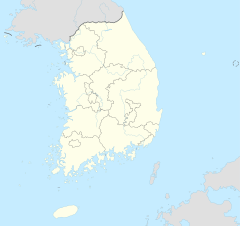User:Templestaykorea/sandbox
| Geumsunsa Temple | |
|---|---|
 View of Geumsunsa Temple in South Korea | |
| Religion | |
| Affiliation | Jogye Order of Korean Buddhism |
| Location | |
| Location | 137, Bibong-gil, Jongno-gu, Seoul |
| Country | South Korea |
| Geographic coordinates | 37°37′12.30″N 126°57′11.7″E / 37.6200833°N 126.953250°E |
History
[edit]The Temple Associated With the Legend of the Birth of King Sunjo
Geumseonsa (Korean: 금선사, Chinese: 金仙寺, Pronounced “Geum-sun-sa”) is a historic temple located in the southwestern foothills of Bukhansan National Park. It was established in the early Joseon era, about 600 years ago, by Muhak Daesa (無學大師), the monk who assisted King Taejo with founding Joseon and relocating the capital to Hanyang, currently Seoul. Despite its location in the mountains, the temple is easily accessible by a 30-minute trip from the heart of Seoul.
Geumseonsa passes on a legend about King Sunjo dating from the late Joseon era. There was a monk named Yongpa who practiced Buddhism at Pagyesa Temple in Daegu. As most Korean temples were burdened by having to provide compulsory labor to the state, Yongpa came to Seoul to settle the matter with the reigning King Jeongjo. As monks were not allowed to enter Seoul during the Joseon Dynasty, he sold water outside Namdaemun, the southern gate of Seoul, and waited for an opportunity. Eventually he was able to meet with the king and requested a waiver of compulsory labor for monks. King Jeongjo consented on one condition; that Yongpa would offer prayers resulting in the birth of a prince.
Yongpa visited Nongsan, a monk who practiced in a natural cave shrine called Mokjeonggul at Geumseonsa, and discussed the king’s request. They agreed that Nongsan would offer prayers at Mokjeonggul and Yongpa at Naewonam Hermitage on Mt. Suraksan. On their 300th day of prayer, Royal Noble Consort Su of the Bak Clan, one of King Jeongjo’s concubines, had a dream. A monk appeared in her dream and predicted that he would be born as her son. On the same day, Nongsan, who was praying at Mokjeonggul, passed away sitting in meditation.
As predicted, on the 18th day of the 6th lunar month, Royal Noble Consort Su of the Bak Clan gave birth to a son who later was enthroned as King Sunjo. Mokjeonggul, where Nongsan offered prayers to fulfill the king’s request, was renovated recently, and an Avalokitesvara Statue was enshrined within it. To commemorate the legend, Geumseonsa offers a birthday ritual for King Sunjo on the 18th day of the 6th lunar month every year.
Cultural Assets
[edit]The Site where Ven. Nongsan Entered Nirvana 220 Years ago
Geumseonsa doesn’t have a lot of tangible cultural heritage items as it has only been 60 years since the temple was reconstructed after being totally destroyed by fire during the Japanese occupation. The Scroll Painting of Guardian Deities, Seoul’s Tangible Cultural Heritage No. 161, is the only one of its kind. Produced in 1887, the painting features Indra in the upper part of the painting and Skanda in the lower part. Both are kings of guardian deities who support and protect the Buddha-Dharma.
If one walks along the path to the entrance of Geumseonsa until the temple’s tiled roof comes into view, one can turn off onto a path that heads down into a valley. This leads to a natural cave shrine named Mokjeonggul. Under a giant rock in this valley is a natural cave Dharma hall through which one can enter the temple compound. In this Dharma hall, Ven. Nongsan offered prayers and entered nirvana 220 years ago.
Landscape
[edit]Kim Jeong-hui Climbed Bibong Peak
The western peaks of Mt. Bukhansan are often compared to two eminent Korean monks, Wonhyo and Uisang, sitting in Seon meditation, and its southern peaks to two major bodhisattvas, Manjusri and Samantabhadra, looking down on the capital city of Seoul. At the end of the southern mountain ridge are a monument and incense burner to present offerings to these two bodhisattvas.
The monument on Bibong Peak was previously thought to have been dedicated to Muhak Daesa until Kim Jeong-hui (金正喜, pen name: Chusa), a celebrated scholar of late Joseon, climbed the peak. Kim Jeong-hui was reading books at Seunggasa, one of the temples on Bukhansan, and one day he decided to climb Bibong Peak. He thought that if someone had climbed up there and established a monument, it wouldn’t be too difficult for him to climb up and check it out.
After making an ink rubbing of the monument’s inscription, he discovered it was named “Jinheungwang sunsubi” (Monument commemorating the border inspection on Mt. Bukhansan by King Jinheung), and that it was over 1,000 years old. Alas! This goes to show that just because many people think something is true, doesn’t make it so, but dedicated investigation will eventually lead to the truth.
Templestay program
[edit]Geumsunsa temple offers Templestay programs for visitors where visitors can experience Buddhist culture.
Gallery
[edit]
External links
[edit]
Category:Buddhist temples in South Korea
Notes
[edit]a His ceremonial title was:[1]
"สมเด็จพระญาณสังวร บรมนริศรธรรมนีติภิบาล อริยวงศาคตญาณวิมล สกลมหาสังฆปริณายก ตรีปิฎกปริยัตติธาดา วิสุทธจริยาธิสมบัติ สุวัฑฒนภิธานสงฆวิสุต ปาวจนุตตมพิสาร สุขุมธรรมวิธานธำรง วชิรญาณวงศวิวัฒ พุทธบริษัท คารวสถาน วิจิตรปฏิภาณพัฒนคุณ วิบุลสีลาจารวัตรสุนทร บวรธรรมบพิตร สรรพคณิศรมหาปธานาธิบดี คามวาสี อรัณยวาสี สมเด็จพระสังฆราช"
"(RTGS: Somdet Phra Yannasangwon Borommanaritsonthammanitiphiban Ariyawongsakhatayannawimon Sakonlamahasangkhaparinayok Tripidokpariyattithada Wisutthachariyathisombat Suwatthanaphithanasongkhawisut Pawachanuttamaphisan Sukhumthammawithanthamrong Wachirayanawongsasiwat Phutthaborisat Kharawasathan Wichitpatiphanphatthanakhun Wibunsilacharawattrasunthon Bowonthammabophit Sapphakhanitson Mahapathanathibodi Khamawasi Aranyawasi Somdet Phra Sangkharat)."

